Spatiotemporal Landslide Susceptibility Mapping Incorporating the Effects of Heavy Rainfall: A Case Study of the Heavy Rainfall in August 2021 in Kitakyushu, Fukuoka, Japan
Abstract
:1. Introduction
2. Materials and Methods
2.1. Methodological Flow
2.2. Factor Selection Methods
2.3. Landslide Susceptibility Assessment (LSA) Methods
2.3.1. Random Forest (RF) Model
2.3.2. Deep Belief Networks (DBN) Model
2.3.3. Support Vector Machines (SVM) Model
2.4. Effective Rainfall Model (ERM)
2.5. Validation Methods
3. Study Area and Dataset
3.1. Study Area
3.2. Condition Factors
3.3. Heavy Rainfall Data and Landslide Warning Map
4. Results
4.1. Selection of Spatial Influencing Factors
4.2. Spatial Landslide Susceptibility Mapping (LSMs) and Validation
4.3. Spatiotemporal LSMs and Validation
5. Discussion
6. Conclusions
Author Contributions
Funding
Institutional Review Board Statement
Informed Consent Statement
Data Availability Statement
Conflicts of Interest
References
- Wang, W.; Li, J.; Qu, X.; Han, Z.; Liu, P. Prediction on landslide displacement using a new combination model: A case study of Qinglong landslide in China. Nat. Hazard. 2019, 96, 1121–1139. [Google Scholar] [CrossRef]
- Li, J.; Wang, W.; Han, Z. A variable weight combination model for prediction on landslide displacement using AR model, LSTM model, and SVM model: A case study of the Xinming landslide in China. Environ. Earth Sci. 2021, 80, 386. [Google Scholar] [CrossRef]
- Wang, W.-D.; Li, J.; Han, Z. Comprehensive assessment of geological hazard safety along railway engineering using a novel method: A case study of the Sichuan-Tibet railway, China. Geomat. Nat. Hazards Risk 2020, 11, 1–21. [Google Scholar] [CrossRef] [Green Version]
- Li, J.; Wang, W.-D.; Han, Z.; Chen, G. Analysis of secondary-factor combinations of landslides using improved association rule algorithms: A case study of Kitakyushu in Japan. Geomat. Nat. Hazards Risk 2021, 12, 1885–1904. [Google Scholar] [CrossRef]
- Zhang, S.; Xu, D.; Shen, G.; Liu, J.; Yang, L. Numerical Simulation of Na-Tech Cascading Disasters in a Large Oil Depot. Int. J. Environ. Res. Public Health 2020, 17, 8620. [Google Scholar] [CrossRef] [PubMed]
- Li, J.; Wang, W.-D.; Han, Z.; Li, Y.; Chen, G. Exploring the Impact of Multitemporal DEM Data on the Susceptibility Mapping of Landslides. Appl. Sci. 2020, 10, 2518. [Google Scholar] [CrossRef] [Green Version]
- Xing, X.; Wu, C.; Li, J.; Li, X.; He, R. Susceptibility assessment for rainfall-induced landslides using a revised logistic regression method. Nat. Hazard. 2021, 106, 97–117. [Google Scholar] [CrossRef]
- Liu, X.; Wang, Y. Probabilistic simulation of entire process of rainfall-induced landslides using random finite element and material point methods with hydro-mechanical coupling. Comput. Geotech. 2021, 132, 103989. [Google Scholar] [CrossRef]
- Calcaterra, D.; Parise, M.; Palma, B.; Pelella, L. The influence of meteoric events in triggering shallow landslides in pyroclastic deposits of Campania, Italy. In Landslides in Research, Theory and Practice, Proceedings of the 8th International Symposium on Landslides, Cardiff, UK, 26–30 June 2000; Thomas Telford Publishing: London, UK, 2000. [Google Scholar]
- Andrea, C.; Pierluigi, B.; Claudia, S.; Ivano, R. Relationships between geo-hydrological processes induced by heavy rainfall and land-use: The case of 25 October 2011 in the Vernazza catchment (Cinque Terre, NW Italy). J. Maps 2013, 9, 289–298. [Google Scholar] [CrossRef]
- Bordoni, M.; Meisina, C.; Valentino, R.; Lu, N.; Bittelli, M.; Chersich, S. Hydrological factors affecting rainfall-induced shallow landslides: From the field monitoring to a simplified slope stability analysis. Eng. Geol. 2015, 193, 19–37. [Google Scholar] [CrossRef]
- Ng, C.; Yang, B.; Liu, Z.Q.; Kwan, J.; Chen, L. Spatiotemporal modelling of rainfall-induced landslides using machine learning. Landslides 2021, 18, 2499–2514. [Google Scholar] [CrossRef]
- Dahal, R.K.; Hasegawa, S.; Nonomura, A.; Yamanaka, M.; Masuda, T.; Nishino, K. GIS-based weights-of-evidence modelling of rainfall-induced landslides in small catchments for landslide susceptibility mapping. Environ. Geol. 2008, 54, 311–324. [Google Scholar] [CrossRef]
- Schilirò, L.; Cepeda, J.; Devoli, G.; Piciullo, L. Regional Analyses of Rainfall-Induced Landslide Initiation in Upper Gudbrandsdalen (South-Eastern Norway) Using TRIGRS Model. Geosciences 2021, 11, 35. [Google Scholar] [CrossRef]
- Roessner, S.; Wetzel, H.U.; Kaufmann, H.; Sarnagoev, A. Potential of Satellite Remote Sensing and GIS for Landslide Hazard Assessment in Southern Kyrgyzstan (Central Asia). Nat. Hazard. 2005, 35, 395–416. [Google Scholar] [CrossRef]
- Wu, C. Landslide Susceptibility Based on Extreme Rainfall-Induced Landslide Inventories and the Following Landslide Evolution. Water 2019, 11, 2609. [Google Scholar] [CrossRef] [Green Version]
- Choi, J.; Oh, H.J.; Lee, H.J.; Lee, C.; Lee, S. Combining landslide susceptibility maps obtained from frequency ratio, logistic regression, and artificial neural network models using ASTER images and GIS. Eng. Geol. 2012, 124, 12–23. [Google Scholar] [CrossRef]
- Pourghasemi, H.R.; Sadhasivam, N.; Amiri, M.; Eskandari, S.; Santosh, M. Landslide susceptibility assessment and mapping using state-of-the art machine learning techniques. Nat. Hazard. 2021, 108, 1291–1316. [Google Scholar] [CrossRef]
- Goyes-Peñafiel, P.; Hernandez-Rojas, A. Landslide susceptibility index based on the integration of logistic regression and weights of evidence: A case study in Popayan, Colombia. Eng. Geol. 2021, 280, 105958. [Google Scholar] [CrossRef]
- Mandal, K.; Saha, S.; Mandal, S. Applying deep learning and benchmark machine learning algorithms for landslide susceptibility modelling in Rorachu river basin of Sikkim Himalaya, India. Geosci. Front. 2021, 12, 101203. [Google Scholar] [CrossRef]
- Tanyu, B.F.; Abbaspour, A.; Alimohammadlou, Y.; Tecuci, G. Landslide susceptibility analyses using Random Forest, C4.5, and C5.0 with balanced and unbalanced datasets. CATENA 2021, 203, 105355. [Google Scholar] [CrossRef]
- Hong, H.; Tsangaratos, P.; Ilia, I.; Loupasakis, C.; Wang, Y. Introducing a novel multi-layer perceptron network based on stochastic gradient descent optimized by a meta-heuristic algorithm for landslide susceptibility mapping. Sci. Total Environ. 2020, 742, 140549. [Google Scholar] [CrossRef] [PubMed]
- García-Rodríguez, M.; Malpica, J.A. Assessment of earthquake-triggered landslide susceptibility in El Salvador based on an Artificial Neural Network model. Nat. Hazards Earth Syst. Sci. 2010, 10, 1307–1315. [Google Scholar] [CrossRef]
- Chen, X.; Chen, W. GIS-based landslide susceptibility assessment using optimized hybrid machine learning methods. CATENA 2021, 196, 104833. [Google Scholar] [CrossRef]
- Hong, H.; Aiding, K.; Adel, S.; Razavi, T.; Liu, J.; Zhu, A.X.; Yari, H.A.; Bin, A.B.; Wang, Y. Landslide susceptibility assessment in the Anfu County, China: Comparing different statistical and probabilistic models considering the new topo-hydrological factor (HAND). Earth Sci. Inform. 2018, 11, 605–622. [Google Scholar] [CrossRef]
- Du, J.; Glade, T.; Woldai, T.; Chai, B.; Zeng, B. Landslide susceptibility assessment based on an incomplete landslide inventory in the Jilong Valley, Tibet, Chinese Himalayas. Eng. Geol. 2020, 270, 105572. [Google Scholar] [CrossRef]
- Nepal, N.; Chen, J.; Chen, H.; Wang, X.A.; Pangali Sharma, T.P. Assessment of landslide susceptibility along the Araniko Highway in Poiqu/Bhote Koshi/Sun Koshi Watershed, Nepal Himalaya. Prog. Disaster Sci. 2019, 3, 100037. [Google Scholar] [CrossRef]
- Saha, A.; Saha, S. Comparing the efficiency of weight of evidence, support vector machine and their ensemble approaches in landslide susceptibility modelling: A study on Kurseong region of Darjeeling Himalaya, India. Remote Sens. Appl. Soc. Environ. 2020, 19, 100323. [Google Scholar] [CrossRef]
- Ozdemir, A.; Altural, T. A comparative study of frequency ratio, weights of evidence and logistic regression methods for landslide susceptibility mapping: Sultan Mountains, SW Turkey. J. Asian Earth Sci. 2013, 64, 180–197. [Google Scholar] [CrossRef]
- Wang, Y.; Feng, L.; Li, S.; Ren, F.; Du, Q. A hybrid model considering spatial heterogeneity for landslide susceptibility mapping in Zhejiang Province, China. CATENA 2020, 188, 104425. [Google Scholar] [CrossRef]
- Hu, Q.; Zhou, Y.; Wang, S.; Wang, F. Machine learning and fractal theory models for landslide susceptibility mapping: Case study from the Jinsha River Basin. Geomorphology 2020, 351, 106975. [Google Scholar] [CrossRef]
- Thi Ngo, P.T.; Panahi, M.; Khosravi, K.; Ghorbanzadeh, O.; Kariminejad, N.; Cerda, A.; Lee, S. Evaluation of deep learning algorithms for national scale landslide susceptibility mapping of Iran. Geosci. Front. 2021, 12, 505–519. [Google Scholar] [CrossRef]
- Wang, Y.; Fang, Z.; Wang, M.; Peng, L.; Hong, H. Comparative study of landslide susceptibility mapping with different recurrent neural networks. Comput. Geosci. 2020, 138, 104445. [Google Scholar] [CrossRef]
- Hoang, N.D.; Tien Bui, D. Spatial prediction of rainfall-induced shallow landslides using gene expression programming integrated with GIS: A case study in Vietnam. Nat. Hazard. 2018, 92, 1871–1887. [Google Scholar] [CrossRef]
- Tseng, C.-M.; Chen, Y.-R.; Wu, S.-M. Scale and spatial distribution assessment of rainfall-induced landslides in a catchment with mountain roads. Nat. Hazards Earth Syst. Sci. 2018, 18, 687–708. [Google Scholar] [CrossRef] [Green Version]
- Conte, E.; Troncone, A. Stability analysis of infinite clayey slopes subjected to pore pressure changes. Géotechnique 2012, 62, 87–91. [Google Scholar] [CrossRef]
- Conte, E.; Troncone, A. Analytical Method for Predicting the Mobility of Slow-Moving Landslides owing to Groundwater Fluctuations. J. Geotech. Geoenviron. Eng. 2011, 137, 777–784. [Google Scholar] [CrossRef]
- Baymani-Nezhad, M.; Han, D. Hydrological modeling using Effective Rainfall routed by the Muskingum method (ERM). J. Hydroinf. 2013, 15, 1437–1455. [Google Scholar] [CrossRef]
- Ma, T.; Li, C.; Lu, Z.; Wang, B. An effective antecedent precipitation model derived from the power-law relationship between landslide occurrence and rainfall level. Geomorphology 2014, 216, 187–192. [Google Scholar] [CrossRef]
- Akinwande, O.; Dikko, H.G.; Agboola, S. Variance Inflation Factor: As a Condition for the Inclusion of Suppressor Variable(s) in Regression Analysis. Open J. Stat. 2015, 05, 754–767. [Google Scholar] [CrossRef] [Green Version]
- Garcia, C.; Pérez, J.; López Martín, M.; Salmerón, R. Collinearity: Revisiting the variance inflation factor in ridge regression. J. Appl. Stat. 2015, 42, 648–661. [Google Scholar] [CrossRef]
- Sun, D.; Wen, H.; Wang, D.; Xu, J. A random forest model of landslide susceptibility mapping based on hyperparameter optimization using Bayes algorithm. Geomorphology 2020, 362, 107201. [Google Scholar] [CrossRef]
- Wang, W.; He, Z.; Han, Z.; Li, Y.; Dou, J.; Huang, J. Mapping the susceptibility to landslides based on the deep belief network: A case study in Sichuan Province, China. Nat. Hazards 2020, 103, 3239–3261. [Google Scholar] [CrossRef]
- Youssef, A.M.; Pourghasemi, H.R.; Pourtaghi, Z.S.; Al-Katheeri, M.M. Landslide susceptibility mapping using random forest, boosted regression tree, classification and regression tree, and general linear models and comparison of their performance at Wadi Tayyah Basin, Asir Region, Saudi Arabia. Landslides 2016, 13, 839–856. [Google Scholar] [CrossRef]
- Sun, D.; Xu, J.; Wen, H.; Wang, Y. An Optimized Random Forest Model and Its Generalization Ability in Landslide Susceptibility Mapping: Application in Two Areas of Three Gorges Reservoir, China. J. Earth Sci. 2020, 31, 1068–1086. [Google Scholar] [CrossRef]
- Xie, X.A.; Fu, G.A.; Xue, Y.A.; Zhao, Z.A.; Chen, P.A.; Lu, B.B.; Jiang, S.C. Risk prediction and factors risk analysis based on IFOA-GRNN and apriori algorithms: Application of artificial intelligence in accident prevention. Process Saf. Environ. Prot. 2019, 122, 169–184. [Google Scholar] [CrossRef]
- Lü, Q.; Dou, Y.; Niu, X.; Xu, J.; Xia, F. Remote Sensing Image Classification Based on DBN Model. J. Comput. Res. Dev. 2014, 51, 1911–1918. [Google Scholar]
- Kohler, M.; Richards, M. Multicapacity Basin Accounting for Predicting Runoff from Storm Precipitation. J. Geophys. Res. 1962, 67, 5187–5197. [Google Scholar] [CrossRef]
- Alatorre, L.C.; Raquel, S.A.; Santos, C.; Santiago, B.; Salvador, S.C. Identification of Mangrove Areas by Remote Sensing: The ROC Curve Technique Applied to the Northwestern Mexico Coastal Zone Using Landsat Imagery. Remote Sens. 2011, 3, 1568–1583. [Google Scholar] [CrossRef] [Green Version]
- Tsangaratos, P.; Ilia, I.; Hong, H.; Chen, W.; Xu, C. Applying Information Theory and GIS-based quantitative methods to produce landslide susceptibility maps in Nancheng County, China. Landslides 2017, 14, 1091–1111. [Google Scholar] [CrossRef]
- Napoli, M.; Carotenuto, F.; Cevasco, A.; Confuorto, P.; Calcaterra, D. Machine learning ensemble modelling as a tool to improve landslide susceptibility mapping reliability. Landslides 2020, 17, 1897–1914. [Google Scholar] [CrossRef]
- Li, Y.; Liu, X.; Han, Z.; Dou, J. Spatial Proximity-Based Geographically Weighted Regression Model for Landslide Susceptibility Assessment: A Case Study of Qingchuan Area, China. Appl. Sci. 2020, 10, 1107. [Google Scholar] [CrossRef] [Green Version]
- Mukherji, A.; Scott, C.; Molden, D.; Maharjan, A. Megatrends in Hindu Kush Himalaya: Climate Change, Urbanisation and Migration and Their Implications for Water, Energy and Food. In Assessing Global Water Megatrends; Springer: Singapore, 2018. [Google Scholar]
- Wester, P.; Mishra, A.; Mukherji, A.; Shrestha, A.B. The Hindu Kush Himalaya Assessment: Mountains, Climate Change, Sustainability and People; Springer Nature: Cham, Switzerland, 2019. [Google Scholar]
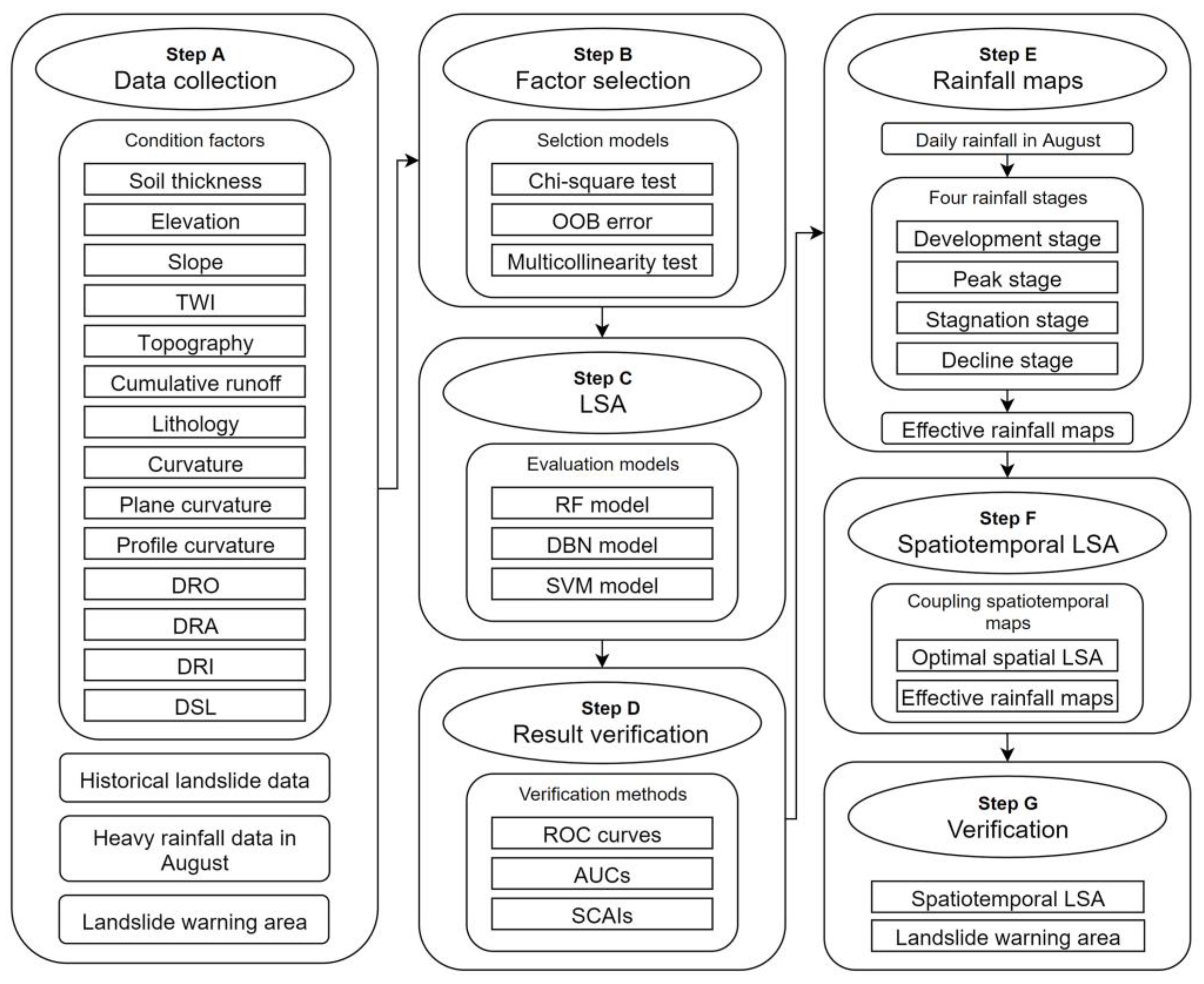
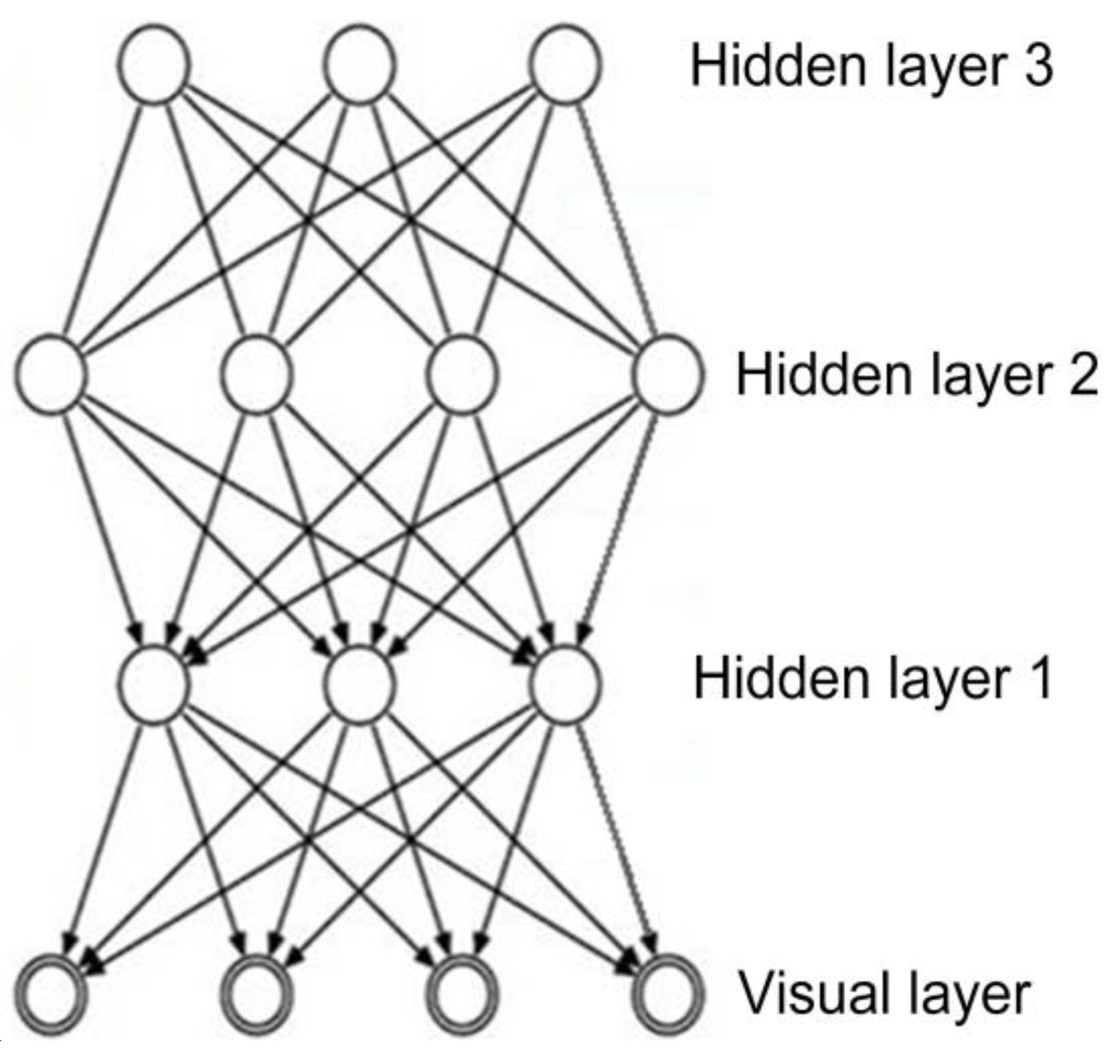
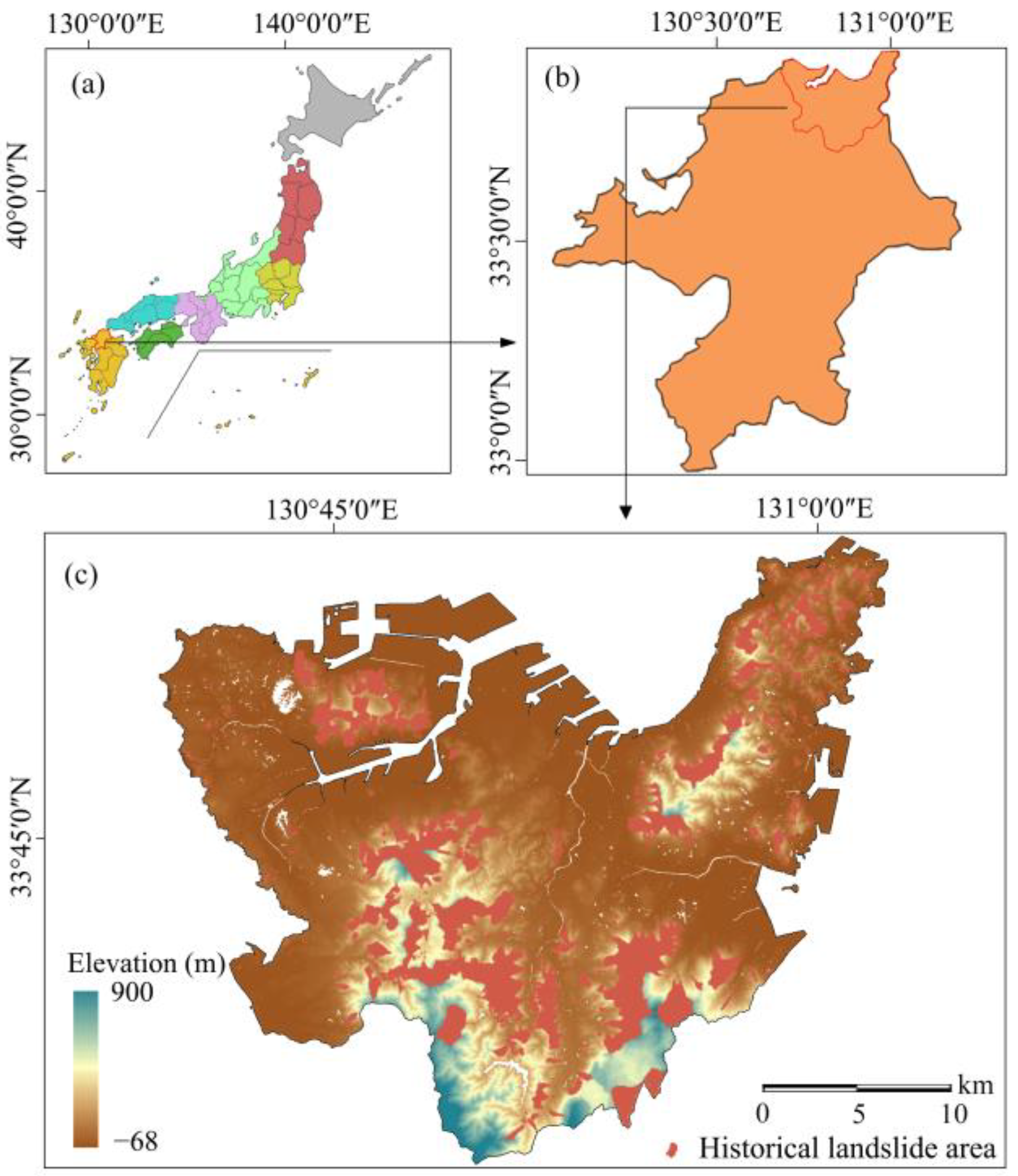
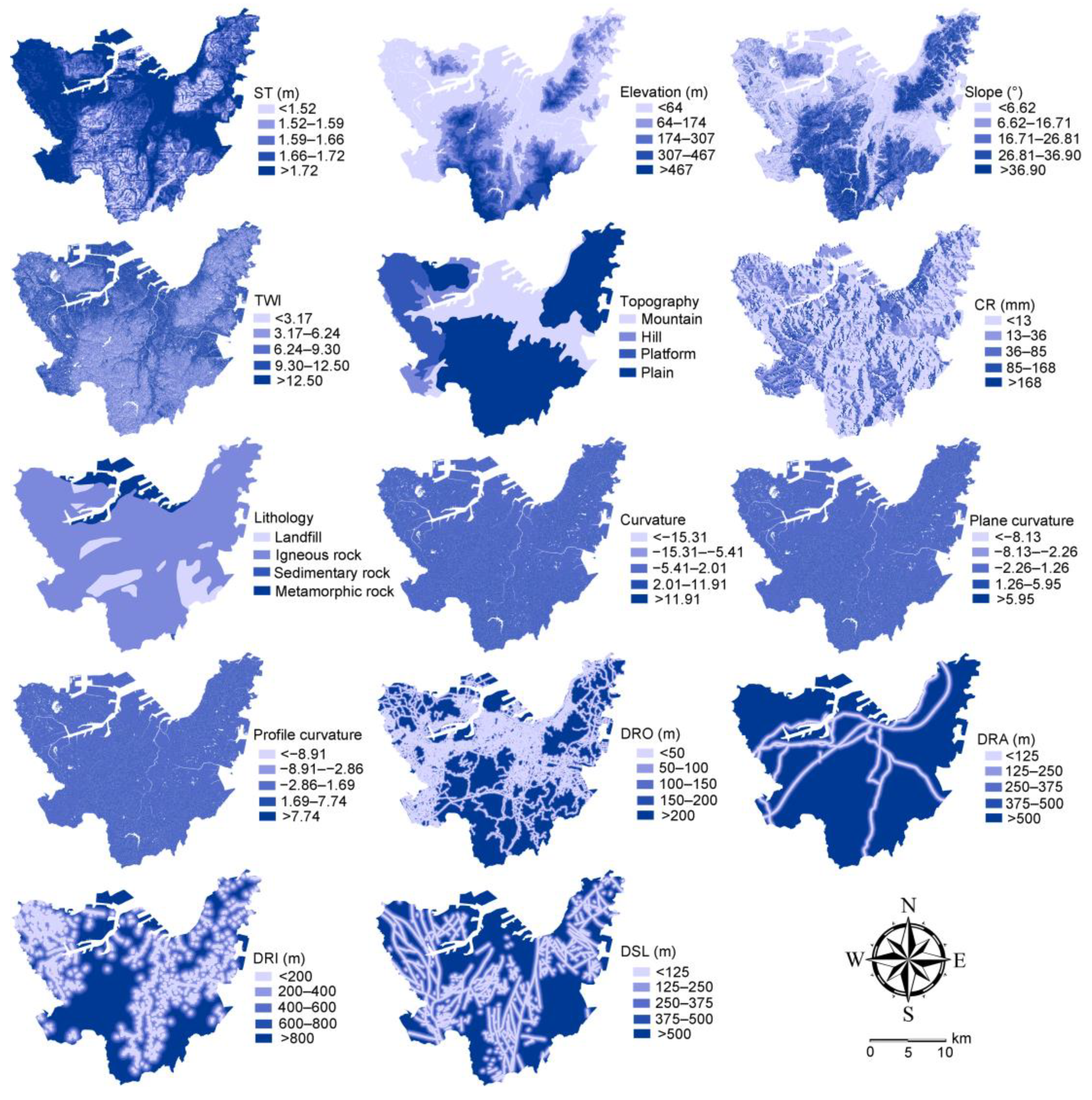
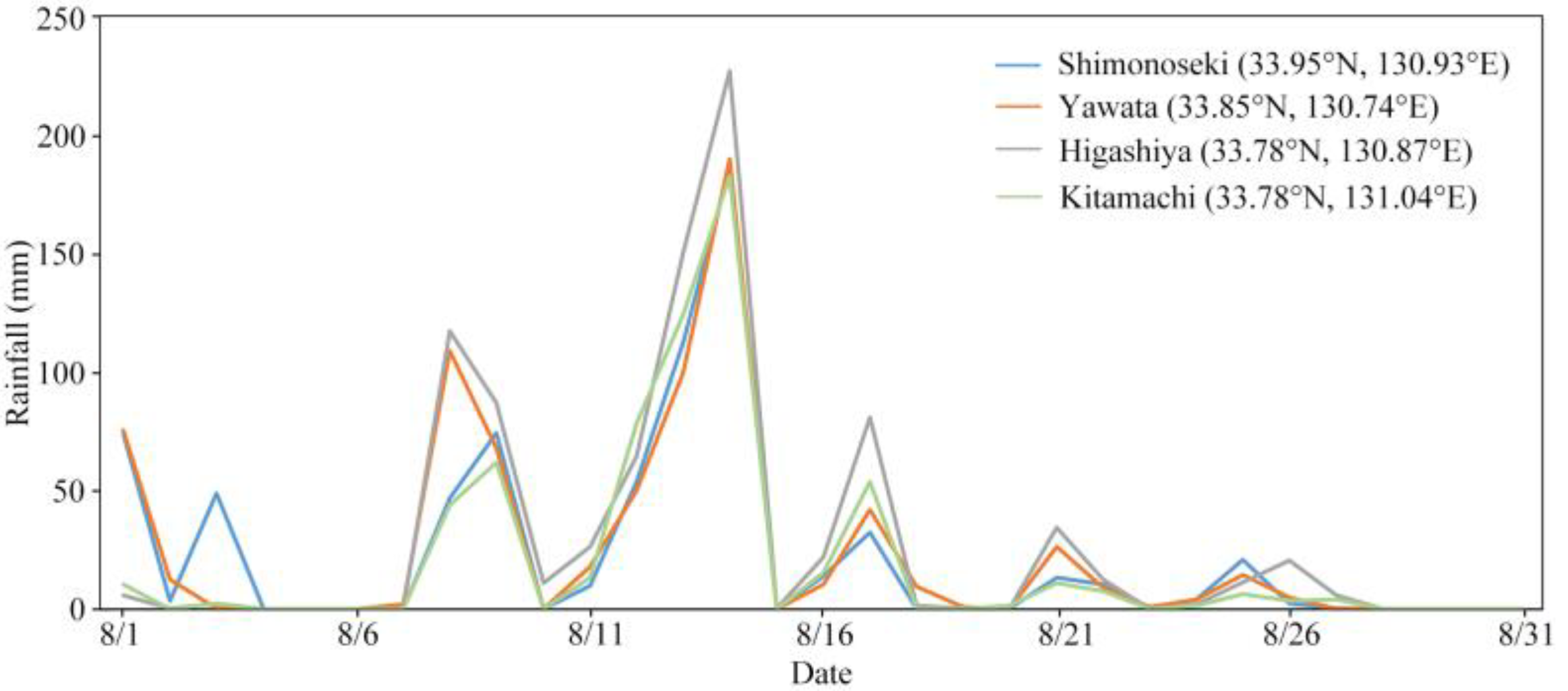
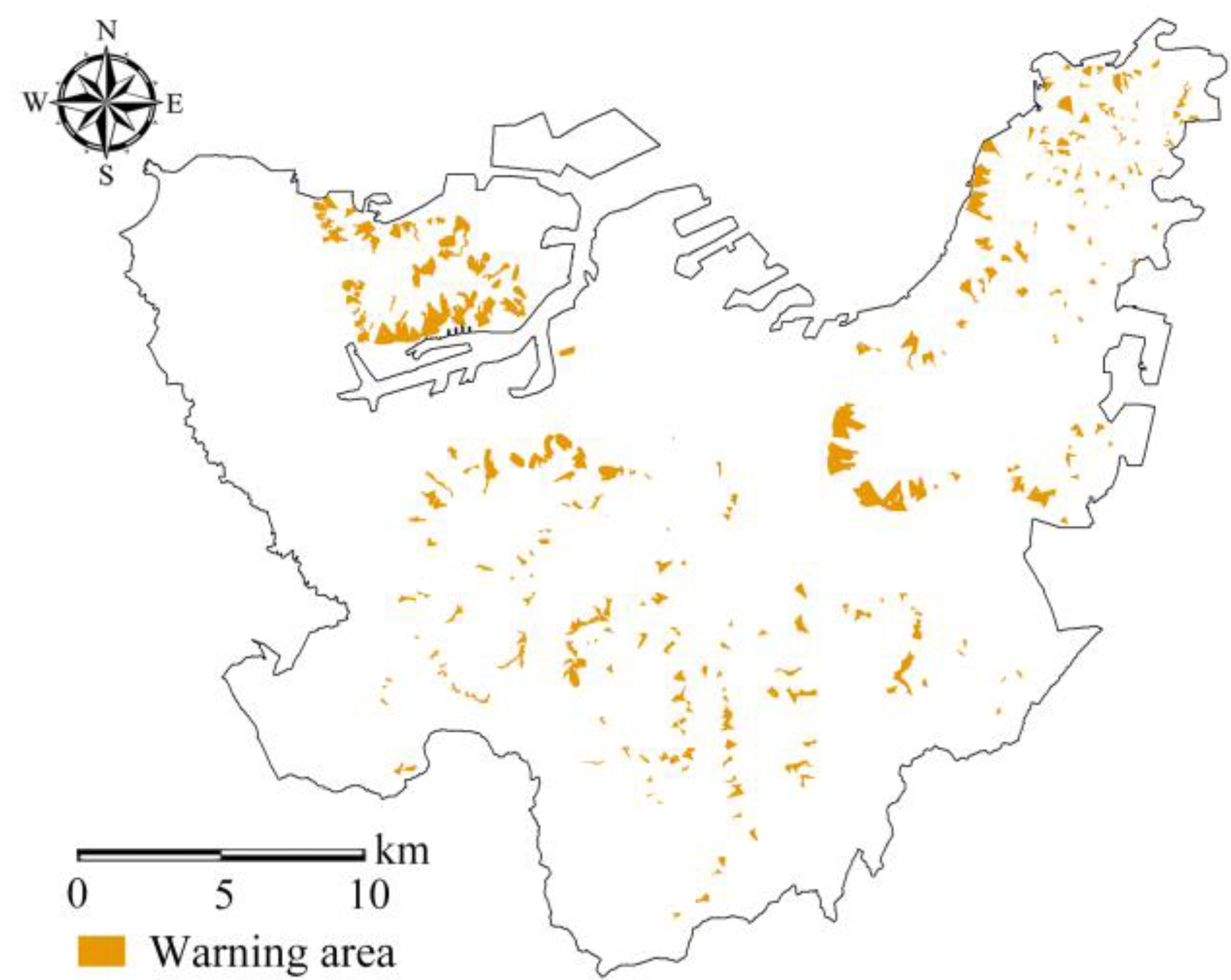
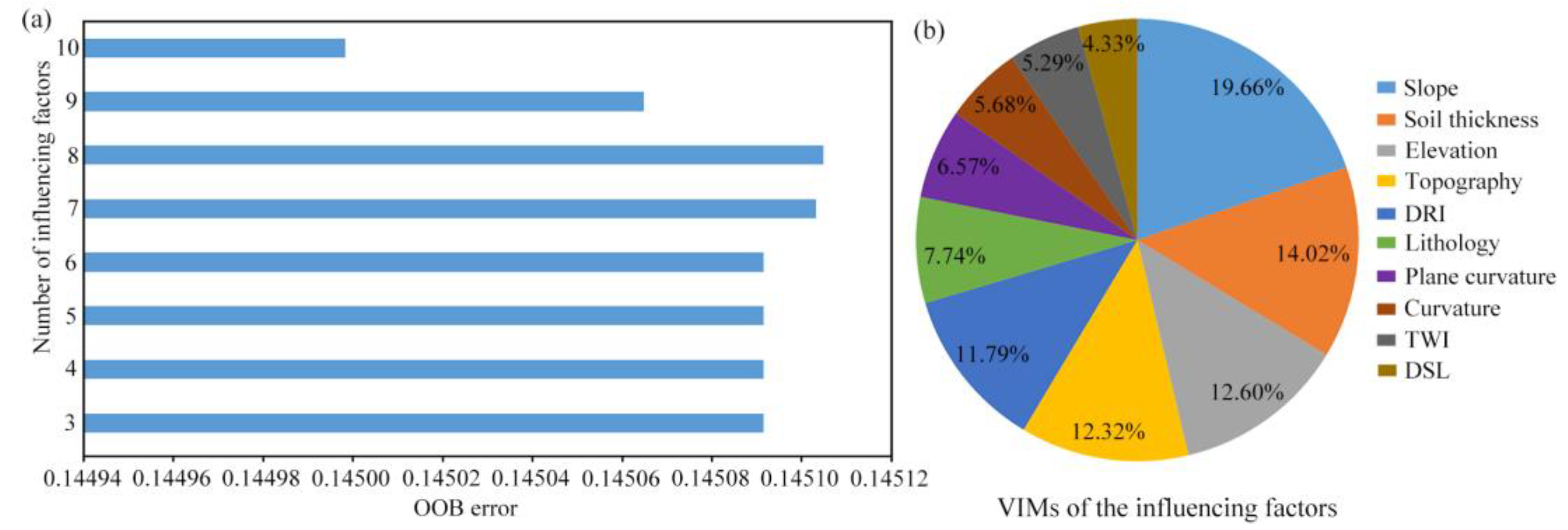

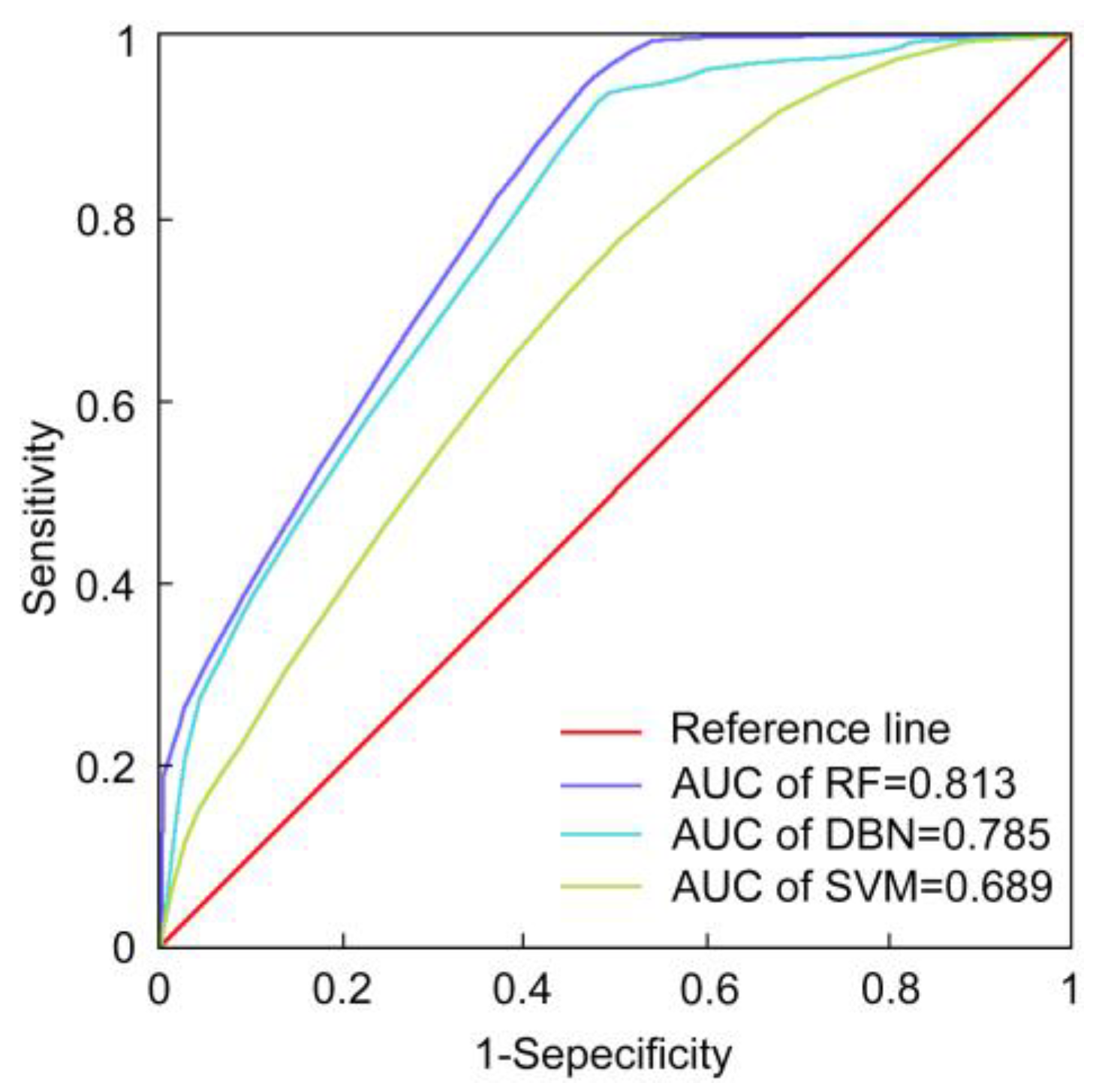
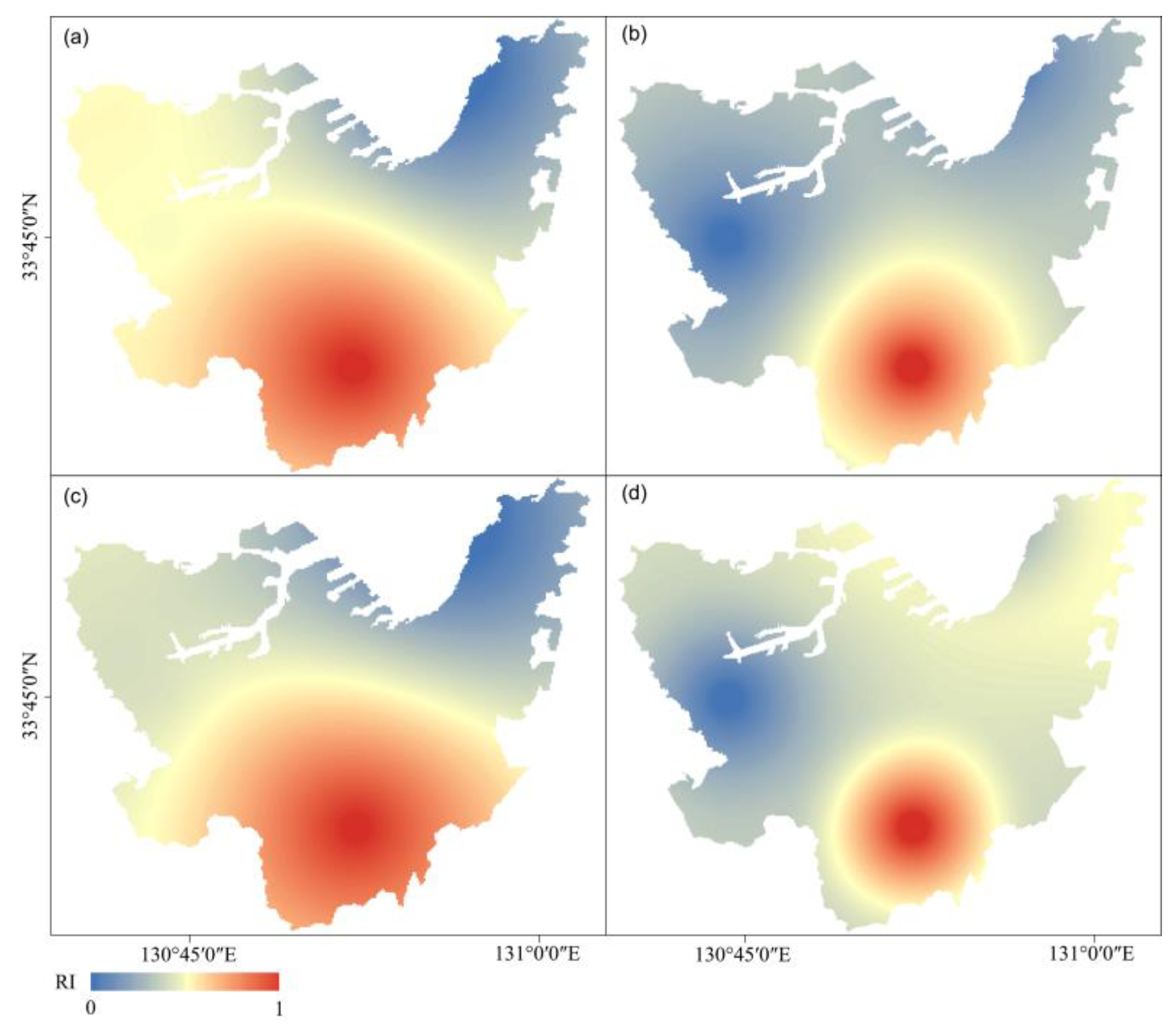
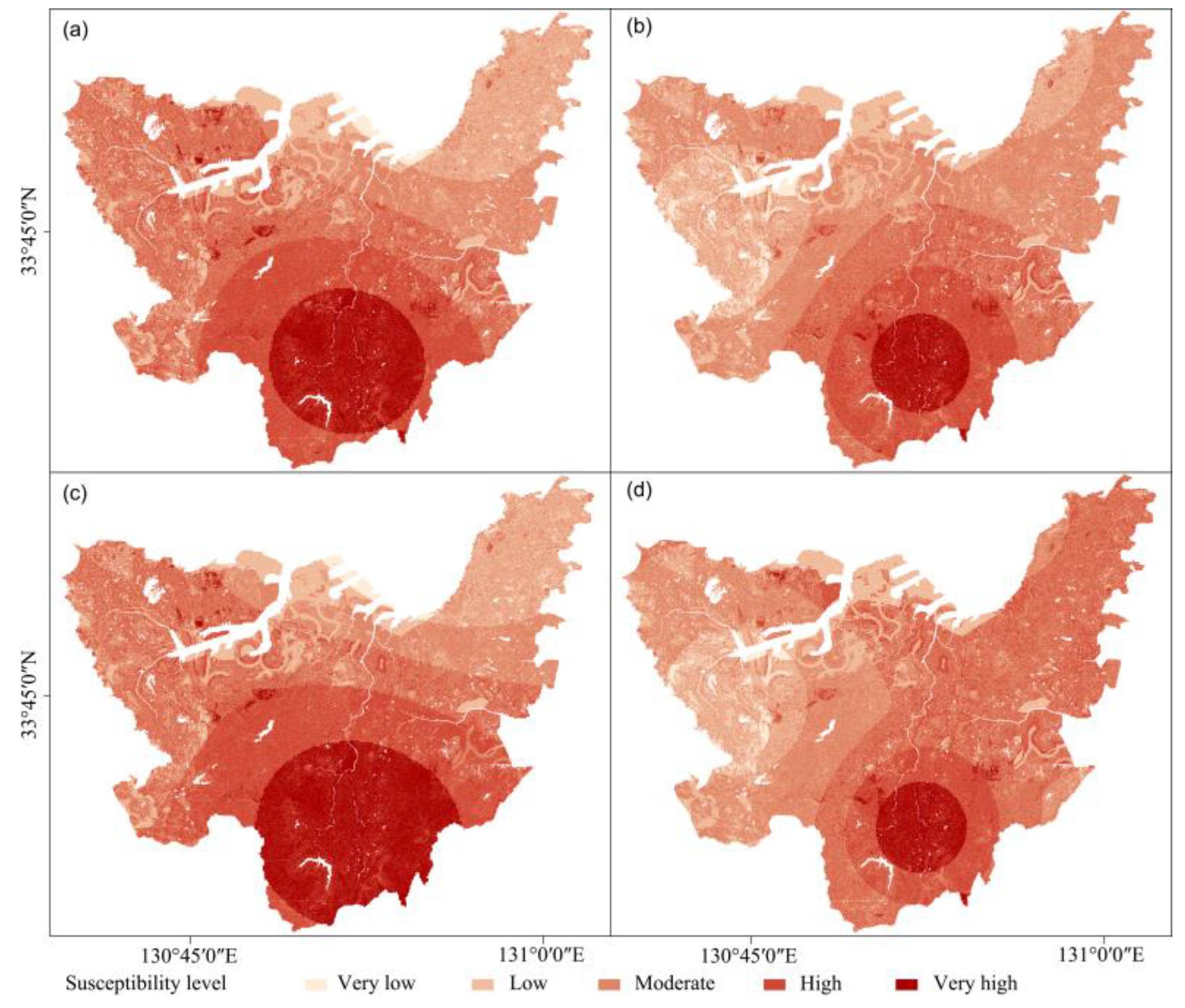
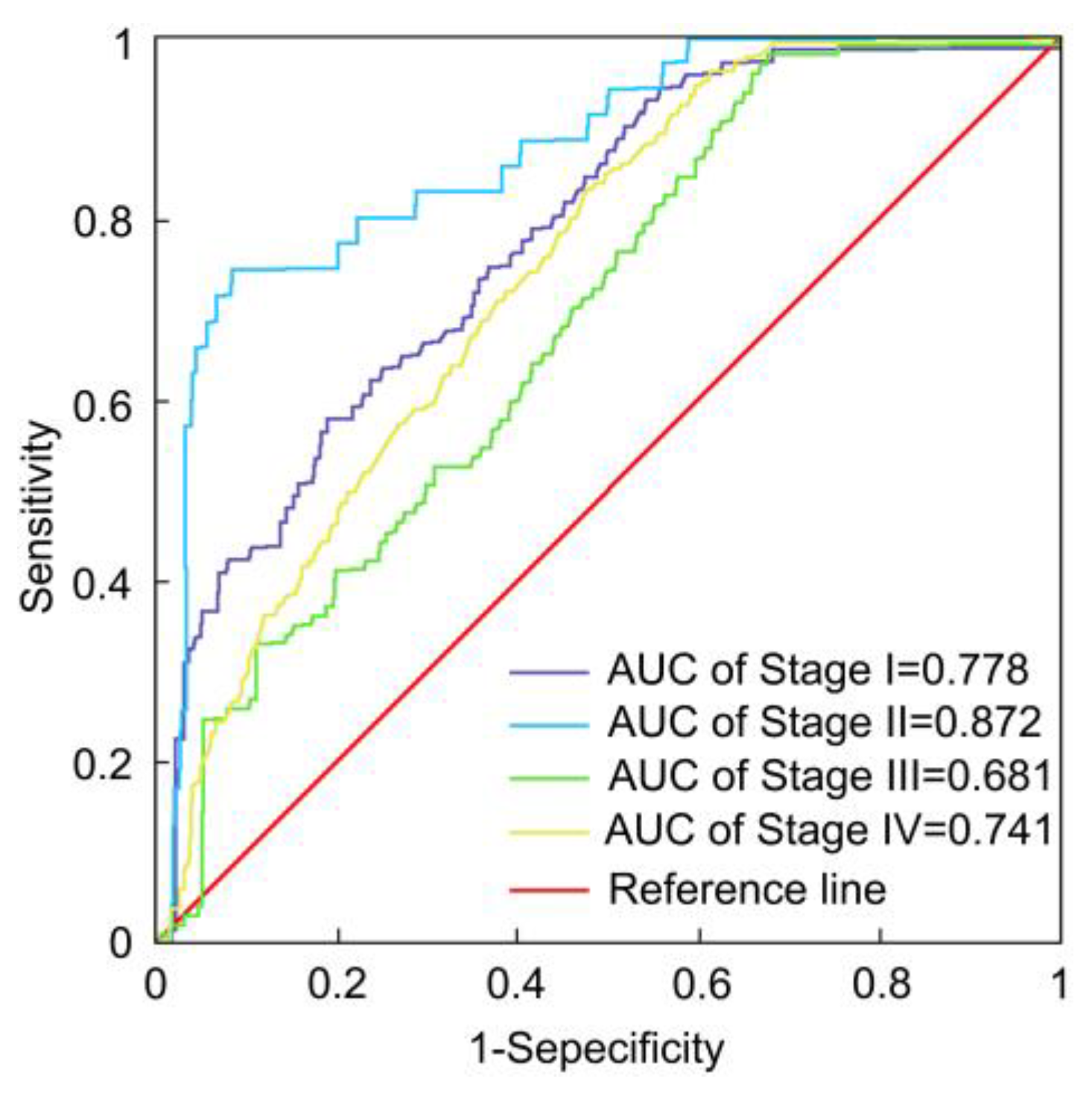
| Factors | Factors | ||
|---|---|---|---|
| Soil thickness | 36.77 | Curvature | 5.85 |
| Elevation | 41.27 | Plane curvature | 8.15 |
| Slope | 31.71 | Profile curvature | 3.10 |
| TWI | 9.56 | DRO | 3.10 |
| Topography | 27.77 | DRA | 3.22 |
| Cumulative runoff | 0.73 | DRI | 10.79 |
| Lithology | 14.73 | DSL | 4.60 |
| Factors | VIFs | Factors | VIFs |
|---|---|---|---|
| Slope | 1.327 | Lithology | 1.105 |
| Soil thickness | 1.186 | Plane curvature | 1.109 |
| Elevation | 1.446 | Curvature | 1.103 |
| Topography | 1.384 | TWI | 1.173 |
| DRI | 1.078 | DSL | 1.033 |
| Models | Very Low | Low | Moderate | High | Very High |
|---|---|---|---|---|---|
| RF model | 15.25% | 15.30% | 40.05% | 27.45% | 1.95% |
| DBN model | 12.27% | 9.48% | 53.62% | 19.13% | 5.50% |
| SVM model | 20.14% | 1.16% | 71.37% | 6.24% | 1.09% |
| Model | Level | Area Percentage | Landslide Area (km2) | Landslide Percentage | SCAI |
|---|---|---|---|---|---|
| RF model | Very low | 15.25% | 0.208 | 0.24% | 63.40 |
| Low | 15.30% | 12.888 | 14.90% | 1.03 | |
| Moderate | 40.05% | 40.603 | 46.95% | 0.85 | |
| High | 27.45% | 26.342 | 30.46% | 0.90 | |
| Very high | 1.95% | 6.443 | 7.45% | 0.26 | |
| DBN model | Very low | 12.27% | 0.367 | 0.42% | 28.91 |
| Low | 9.48% | 0.482 | 0.56% | 17.01 | |
| Moderate | 53.62% | 57.368 | 66.34% | 0.81 | |
| High | 19.13% | 18.391 | 21.27% | 0.90 | |
| Very high | 5.50% | 9.876 | 11.42% | 0.48 | |
| SVM model | Very low | 20.14% | 1.668 | 1.93% | 10.44 |
| Low | 1.16% | 2.396 | 2.77% | 0.42 | |
| Moderate | 71.37% | 73.135 | 84.57% | 0.84 | |
| High | 6.24% | 4.955 | 5.73% | 1.09 | |
| Very high | 1.09% | 4.329 | 5.01% | 0.22 |
Publisher’s Note: MDPI stays neutral with regard to jurisdictional claims in published maps and institutional affiliations. |
© 2021 by the authors. Licensee MDPI, Basel, Switzerland. This article is an open access article distributed under the terms and conditions of the Creative Commons Attribution (CC BY) license (https://creativecommons.org/licenses/by/4.0/).
Share and Cite
Li, J.; Wang, W.; Li, Y.; Han, Z.; Chen, G. Spatiotemporal Landslide Susceptibility Mapping Incorporating the Effects of Heavy Rainfall: A Case Study of the Heavy Rainfall in August 2021 in Kitakyushu, Fukuoka, Japan. Water 2021, 13, 3312. https://doi.org/10.3390/w13223312
Li J, Wang W, Li Y, Han Z, Chen G. Spatiotemporal Landslide Susceptibility Mapping Incorporating the Effects of Heavy Rainfall: A Case Study of the Heavy Rainfall in August 2021 in Kitakyushu, Fukuoka, Japan. Water. 2021; 13(22):3312. https://doi.org/10.3390/w13223312
Chicago/Turabian StyleLi, Jiaying, Weidong Wang, Yange Li, Zheng Han, and Guangqi Chen. 2021. "Spatiotemporal Landslide Susceptibility Mapping Incorporating the Effects of Heavy Rainfall: A Case Study of the Heavy Rainfall in August 2021 in Kitakyushu, Fukuoka, Japan" Water 13, no. 22: 3312. https://doi.org/10.3390/w13223312
APA StyleLi, J., Wang, W., Li, Y., Han, Z., & Chen, G. (2021). Spatiotemporal Landslide Susceptibility Mapping Incorporating the Effects of Heavy Rainfall: A Case Study of the Heavy Rainfall in August 2021 in Kitakyushu, Fukuoka, Japan. Water, 13(22), 3312. https://doi.org/10.3390/w13223312








